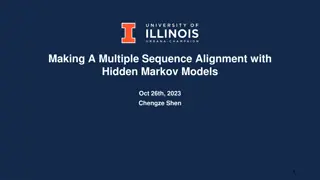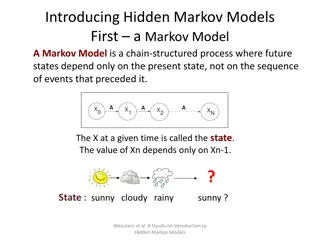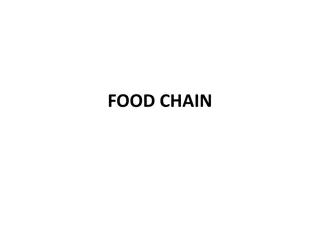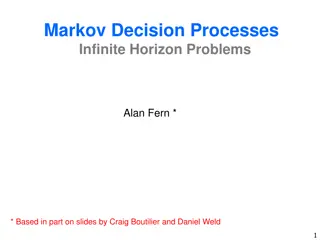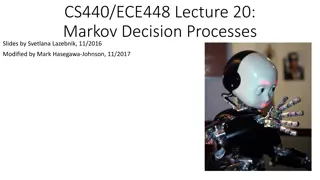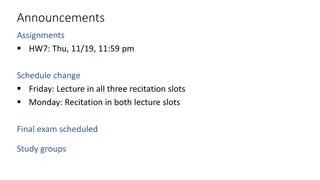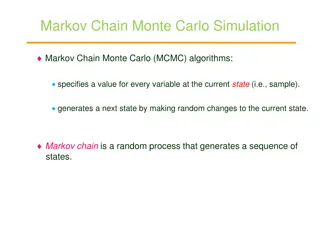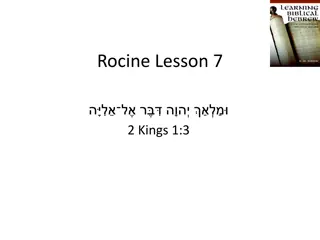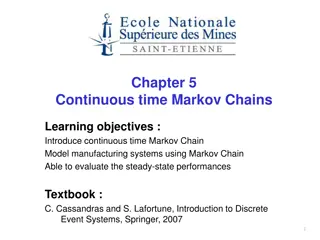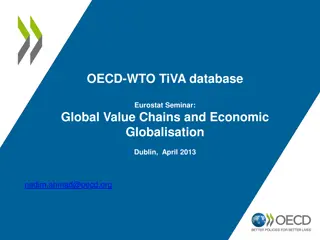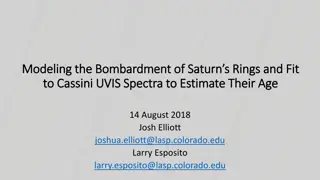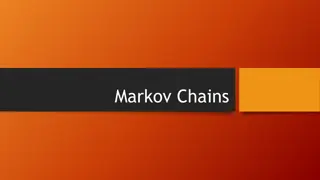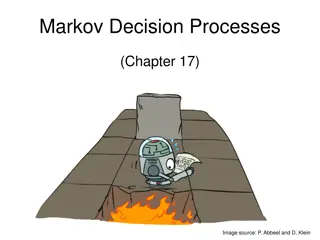Understanding Markov Chains and Their Applications in Networks
Andrej Markov and his contributions to the development of Markov chains are explored, highlighting the principles, algorithms, and rules associated with these probabilistic models. The concept of a Markov chain, where transitions between states depend only on the current state, is explained using weather patterns as an example. The practical applications and calculations involving Markov chains are also discussed in detail.
Download Presentation

Please find below an Image/Link to download the presentation.
The content on the website is provided AS IS for your information and personal use only. It may not be sold, licensed, or shared on other websites without obtaining consent from the author. Download presentation by click this link. If you encounter any issues during the download, it is possible that the publisher has removed the file from their server.
E N D
Presentation Transcript
The chain of Andrej Markov and its applications NETWORKS goes to school - April 23, 2018 Jan-Pieter Dorsman
Some history Andrej Andrejevitz Markov sr. (1856-1922) Markov s inequality Markov numbers Markov networks Markov processes Markov chains Andrej Andrejevitz Markov jr. (1903-1979) Markov s principle Markov algoritm Markov s rule NETWORKS GOES TO SCHOOL 2
Some history Andrej Andrejevitz Markov sr. (1856-1922) Markov s inequality Markov numbers Markov networks Markov processes Markov chains Andrej Andrejevitz Markov jr. (1903-1979) Markov s principle Markov algoritm Markov s rule NETWORKS GOES TO SCHOOL 3
Markov chain A Markov chain describes something that moves step-by-step through a number of states and exhibits transitions from one state to another (or the same) state. In particular, the so-called Markov property holds: The future, given the present, does not depend on the past. NETWORKS GOES TO SCHOOL 4
The weather as Markov chain The situation: If it is sunny today, it will also be sunny tomorrow with probability 90%, but rainy with 10% probability. If it is rainy today, it will be sunny tomorrow with 40% probability, but it will remain rainy with 60% probability. This is a Markov chain with two possible states: sunny and rainy. We can summarise this situation in a graph: 10% 60% Sunny Rainy 90% 40% NETWORKS GOES TO SCHOOL 5
10% 60% Sunny Rainy 90% 40% We can also summarise this in a matrix, which we call P. P is then called the one-step transition matrix. State space: {Sunny, Rainy} To Sunny Rainy Sunny Rainy From ? =0.9 0.1 0.6 0.4 Possible questions we could ask: What is the probability, if it is rainy today, that it will be sunny the day after tomorrow? If it is sunny on Monday, how many sunny days will we have on average from Monday until (and including) Thursday? What percentage of time will it be sunny in the long run? 1. 2. 3. NETWORKS GOES TO SCHOOL 6
10% 60% Sunny Rainy 90% 40% Q: Wat is the probability, if it is rainy today, that it will be sunny the day after tomorrow? A: If sunny tomorrow (prob. 0.4), then day after tomorrow sunny with prob. 0.9. If rainy tomorrow (prob 0.6), then day after tomorrow sunny with prob. 0.4. In total: Q: But what if it didn t say day after tomorrow , but in eight days from now ? A: To this end, we use so-called matrix-multiplication: 0.4x0.9 = 0.36 0.6x0.4 = 0.24 + 0.60 ?2= ? ? =0.9 0.1 0.6 0.9 0.1 0.6 0.4 0.4 0.9 0.1 + 0.1 0.6 0.4 0.1 + 0.6 0.6 =0.9 0.9 + 0.1 0.4 0.4 0.9 + 0.6 0.4 From Sunny Rainy =0.85 0.6 0.15 0.4 Sunny Rainy From This is the two-step transition matrix! NETWORKS GOES TO SCHOOL 7
10% 60% Sunny Rainy 90% 40% Q: Wat is the probability, if it is rainy today, that it will be sunny in eight days from now? A: To this end, we use so-called matrix-multiplication: ?4= ? ? ? ? = ?2 ?2 =0.85 0.15 0.4 0.85 0.6 0.15 0.4 =0.8125 0.75 0.1875 0.25 0.6 ?8= ?4 ?4 =0.8125 =0.801 0.797 0.199 0.203 0.1875 0.25 0.8125 0.75 0.1875 0.25 0.75 So the probability is 0.797. Hard to compute this by mental calculation! NETWORKS GOES TO SCHOOL 8
10% 60% Sunny Rainy 90% 40% Q: If it is sunny on Monday, how many sunny days will we have on average between Monday until (and including) Thursday? A: Again, we check our matrices: ? =0.9 0.1 0.6 ?2=0.85 0.15 0.4 ?3=0.825 0.175 0.3 0.4 0.6 0.7 Tuesday Wednesday Thursday 0.9 0.4 0.1 0.6+0.85 0.15 0.4 +0.825 0.175 0.3 =2.575 0.425 1.3 0.6 0.7 1.7 If it sunny on Monday, then we will have on average 2.575 sunny days between Tuesday until (and including) Thursday. So the answer is 3.575! NETWORKS GOES TO SCHOOL 9
10% 60% Sunny Rainy 90% 40% Q: What percentage of time will it be sunny in the long run? A: Let s have another look at the matrices ? =0.9 0.4 0.6 0.1 ?2=0.85 0.15 0.4 ?3=0.825 0.175 0.3 0.6 0.7 ?8=0.801 0.199 0.203 0.8125 0.75 0.1875 0.25 ?4= 0.797 Wait a minute what if we continue like this? ?10=0.800195 0.799219 0.199805 0.200781 0.800049 0.799805 0.199951 0.2000195 ?12= 0.8 0.8 0.2 0.2. ? = If we would continue, we would obtain So the answer is 80%. The fine print: 0.8 and 0.2 together form the normalised left eigenvector of P corresponding to eigenvalue 1. NETWORKS GOES TO SCHOOL 10
The weather as Markov chain 10% 60% Sunny Rainy 40% 20% 30% 30% 30% 10% 30% 20% 10% 40% 50% Cloudy Stormy 20% 0.321 0.321 0.321 0.321 0.108 0.108 0.108 0.108 0.6 0.2 0.3 0 0.1 0.4 0.2 0.3 0.3 0.3 0.4 0.2 0 0.351 0.351 0.351 0.351 0.220 0.220 0.220 0.220 0.1 0.1 0.5 ? = ? = If it is cloudy today, an arbitrary day in the distant future will be cloudy with probability 32.1%. But, it doesn t matter what the state today is. If it is cloudy today, in the long run 32.1% of all days will be cloudy. But again, the state of today does not matter. NETWORKS GOES TO SCHOOL 11
The weather as Markov chain 10% 60% Sunny Rainy 40% 20% 30% 30% 10% 100% 100% Cloudy Stormy 0.6 0.2 0.0 0.0 0.1 0.4 0.0 0.0 0.3 0.3 1.0 0.0 0 0.00 0.00 0.00 0.00 0.00 0.00 0.00 0.00 0.95 0.82 1.00 0.00 0.05 0.18 0.00 1.00 0.1 0.0 1.0 ? = ? = If it is cloudy today, an arbitrary day in the distant future will be cloudy with probability 100%. But, it really depends on today s state of weather. We just do not know what percentage of time it will be cloudy in the future. It depends on the state of weather today. NETWORKS GOES TO SCHOOL 12
The weather as Markov chain 30% Sunny Rainy 40% 50% 70% 60% 60% 50% Cloudy Stormy 40% If it is cloudy today, an arbitrary day in the distant future will be cloudy with probability 26.8%. It does not really depend on today s weather. If it is sunny today, it will be cloudy 26.8% of the time in the long run. Also 0 0.3 0 0 0.6 0.7 0 0 0.4 0 0.454 0 0 0.454 0 0 0.546 0 0 0.546 0.4 0.5 0 here, today s weather does not really matter. 0.6 0.5 0 0.464 0.464 0 0.536 0.536 0 ?100= ? = 0 0.464 0 0 0.464 0.536 0 0 0.536 0 0.454 0 0 0.454 0 0 0.546 0 0 0.546 0.454 0.454 0 0.546 0.546 0 0.464 0.464 0 0.536 0.536 0 ?101= ?102= NETWORKS GOES TO SCHOOL 13
Googles search engine In a way, Google s search engine is a mathematical function: f(x) = y. x is the search query y contains all websites where x appears, presented in a certain sequence This function is determined by Google s PageRank algorithm. This algorithm searches through a huge network! NETWORKS GOES TO SCHOOL 14
Internet: PageRank algorithm Idea 1: each incoming hyperlink is a vote for a website. Websites A and B each get 1 votes. Websites C and D both get 2 votes. In shares: (0.167, 0.167, 0.33, 0.33) C & D are on top, A & B are on the bottom. Idea 2: a vote of an important website is worth more than a vote of a not so important website. NETWORKS GOES TO SCHOOL 15
Internet: PageRank algorithm Start with an arbitrary distribution of votes: 1. (0.25, 0.25, 0.25, 0.25) Divide the votes of each website equally over the websites where the website links to. 2. Repeat step 2 until the distribution of 3. votes does not change anymore. NETWORKS GOES TO SCHOOL 16
Internet: PageRank algorithm (0.25, 0.25, 0.25, 0.25) A receives 0.125 votes from C B receives 0.125 votes from A C receives 0.25 votes from B and 0.25 votes from D D receives 0.125 votes from A and 0.125 votes from C (0.125, 0.125, 0.5, 0.25) NETWORKS GOES TO SCHOOL 17
Internet: PageRank algorithm (0.125, 0.125, 0.5, 0.25) A receives 0.25 votes from C B receives 0.0625 votes from A C receives 0.125 votes from B and 0.25 votes from D D receives 0.0625 votes from A and 0.25 votes from C (0.25, 0.0625, 0.375, 0.3125) NETWORKS GOES TO SCHOOL 18
Internet: PageRank algorithm ( 43 iterations down the road ) NETWORKS GOES TO SCHOOL 19
Internet: PageRank algorithm The final distribution is: (0.2, 0.1, 0.4, 0.3) Google orders the websites in the sequence C, D, A, B In fact, this is a hidden Markov chain with 0.0 0.0 0.5 0 0.5 0.0 0.0 0.0 0.0 1.0 0.0 1.0 0.5 0.0 0.5 0.0 0.2 0.2 0.2 0.2 0.1 0.1 0.1 0.1 0.4 0.4 0.4 0.4 0.3 0.3 0.3 0.3 ? = ? = The PageRank algorithm is looking for the rows of ? . NETWORKS GOES TO SCHOOL 20
Internet: PageRank algorithm Google indexes not just 4 websites, but about 50 billion of them. Next to this, the internet-network is constantly changing! Websites appear, change and disappear. All this is stochastics. As users, we expect an answer in just a few milliseconds, so we need a fast algorithm anyway! All considerations for future research. NETWORKS GOES TO SCHOOL 21



